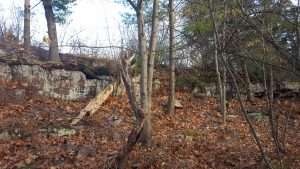
Hoag, Franni. (Oakledge Park Spot) 2016 JPG File

Hoag, Franni. (Oakledge Park Spot) 2016 JPG File
Over the past weekend, I visited my phenology spot one last time before the University of Vermont closes for winter break. The leaves were entirely absent from the hardwood trees and the temperature had dropped substantially. There is no question that it is now winter and everything is getting ready to settle down for several months. The wind was atrocious and the air itself was hardly forgiving. I saw very little evidence of animal life. The Lake looked glassy and although the wind did create a substantial ripple on the surface of the water, there were no white peaks.
In researching Oakledge Park, I found that it became a park in 1999. The first person who owned the land was Albert Brinsmaid in 1793, a Burlington silversmith and jeweler (More than Meets the Eye). In 1850, Napoleon Proctor started a shipyard in South Cove (More than Meets the Eye). In 1883, William Seward Webb bought 245 acres and transformed Oakledge Park into something a little more familiar to what we see today (More than Meets the Eye). Eventually, the Webb Family then went on to establish and live at the famous Shelburne Farms. In 1926, Oakledge was purchased by several Burlington businessmen in hopes of developing it (More than Meets the Eye). In 1961 Oakledge was bought by people who worked for General Electric, and was turned into the Cliffside Country Club (More than Meets the Eye). In 1971, the city of Burlington purchased Oakledge in hopes of turning it into a park (More than Meets the Eye).
The Webbs built a house in 1883, where is now where the picnic stands at Oakledge Park (A Manor for All Seasons). Prior to being a picnic shelter, the house was adapted into part of the Oakledge Manor Resort, which operated from 1926 to 1961 (A Manor for All Seasons). After this, from 1961 through 1970, it was a clubhouse for the Cliffside Country Club (A Manor for All Seasons). In 1971 it was burned to the ground by the Burlington Fire Department in a training exercise (A Manor for All Seasons).
The Oakledge Manor Resort was created by Allen Beech, and could be considered the most notable piece of history about the park surrounding my place. It was a high class establishment, with fine dining, a driving range, horse-back riding, shuffleboard, and tennis (Fun and Games). The Manor has twenty rooms, accompanied by another nine rooms in the gatehouse, and fourteen cottages in the woods surrounding the park (The Lost Resort). Due to it’s relatively close proximity to where the old Manor, as well as being feet away from several chimneys in the woods, I believe that the concrete platform at my site used to be part of a foundation for one of the cottages at the Oakledge Manor Resort. I think that this is really interesting and I am glad that I finally got to the bottom of the strange, concrete platform.
As far as geological history goes, I found out that the park is essentially on top of Monkton Quartzite. The South Cove, where much of this rock is evident, was still a popular swimming place when Oakledge Park operated as a Resort, and one can still find remnants of the rich history that once took place there (History on the Rocks).
I am thankful that I was given the opportunity to go out and explore this spot over the past semester. I ended up becoming quite familiar with it and enjoying the day outings that I took there. I am excited to continue to learn more about it and I found the history of Oakledge Park quite interesting as well.
Sources (I think I found the signs that line the park online):
“A Manor for All Seasons.” (n.d.): n. pag. Lake Champlain Basin Program. Governor’s Institute of Vermont. Web. 10 Dec. 2016. .
“Fun and Games.” (n.d.): n. pag. Lake Champlain Basin Program. Governor’s Institute of Vermont. Web. 10 Dec. 2016. .
“History on the Rocks.” (n.d.): n. pag. Lake Champlain Basin Program. Governor’s Institute of Vermont. Web. 10 Dec. 2016. .
“More than Meets the Eye.” (n.d.): n. pag. Lake Champlain Basin Program. Governor’s Institute of Vermont. Web. 10 Dec. 2016. .
“The Lost Resort.” (n.d.): n. pag. Lake Champlain Basin Program. Governor’s Institute of Vermont. Web. 10 Dec. 2016. .